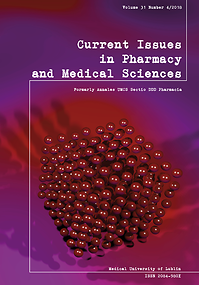In vitro propagated Mentha rotundifolia (L.) Huds and antioxidant activity of its essential oil
DOI:
https://doi.org/10.1515/cipms-2018-0038Keywords:
acclimatization, in vitro culture, essential oils, DPPH, ABTS, CUPRAC, Mentha rotundifolia (L.) HudsAbstract
Mentha rotundifolia (L.) Huds is an aromatic plant used for its medicinal values. This study aims to select appropriate conditions forin vitropropagation ofM. rotundifolia(L.) Huds and to evaluate yield and antioxidants activity of its essential oils (EOs).The explants were cultured on Murashige and Skoog (MS) medium containing different concentrations of growth regulators 6-benzylaminopurine (BAP) and Gibberellin (GA3). Hydrodistillated EOs obtained from acclimatized and mother plant, were evaluated for their antioxidant activity. Tests were performed on DPPH free radical-scavenging, ABTS and CUPRAC assays.
Shoot induction and multiplication were successfully carried out on MS medium supplemented with the following hormones combinations: 1 mg/l BAP, 1 mg/l GA3and 0.5 mg/l BAP, 0.5 mg/l GA3, respectively. Stem length, nodes and leaves number measured from developmentvitroplantwere 6.89 cm, 5.22 nodes and 11.92 leaves pervitroplant, respectively.
In vitro rooted plants were successfully acclimatized at a temperature of 23 ± 2°C and a long day photoperiod with a total survival rate exceeding 95%.EO yield of acclimated plant varied between (0.88-1.49 ml/100 g dry matter) compared to wild plant (0.73 ml/100 g dry matter). The antioxidant potential of EOs from acclimated plant showed on DPPH free radical-scavenging, ABTS and CUPRAC assays values of (IC50: 4.18-24.93 mg/ml), (IC50: 0.51-1.56 mg/ml) and (A0.50: 0.34-2.71 mg/ml), respectively. In contrast, the wild plant exhibited on the same tests the values of (IC50: 10.35 mg/ml), (IC50: 0.12 mg/ml) and (A0.50: 0.99 mg/ml), respectively.The results suggest that micropropagation of M. rotundifolia (L.) Huds can be an interesting alternative for producing important plant material with the possibility to modulate EO yield and its antioxidant potential for future commercial purposes
References
1. Bouhdid S, Idaomar M, Zhiri A, Baudoux D, Skali NS, Abrini J. Thymus essential oils: chemical composition and in vitro antioxidant and antibacterial activities. Inter Congr of Biochem. Agadir, Maroco. 2006;324-7.
2. Zryd JP. Culture of cells, tissues and plant organs. Ed. Presse;1988.
3. Toivonen L. Utilization of hairy root cultures for production of secondary metabolites. Biotechnol Prog. 1993;9:12-20.
4. Srivastava S, Srivastava AK. Hairy root culture for mass-production of high-value secondary metabolites. Crit Rev Biotechnol. 2007; 27:29-43.
5. Drapeau D, Blausch MW, Wilke C. Economic assessment of plant cell cultures for the production of ajmalicine. Biotechnol Bioeng. 1987;30:946-53.
6. Wink M. Biochemistry of Plant Secondary Metabolism. 2ème ed. In Annual plant reviews: 40 Blackwell Publishing Ltd;2010.
7. Murashige T & skoog F. A revised medium for rapid growth and bioassays with tobacco tissue culture. Plant Physiol. 1962;15(3): 473-97.
8. Brand W, Cuvelier W, Berset ME. Use of a free radical method to evaluate antioxydant activity. Lebenson Wiss Technol. 1995;28:25-30.
9. Barkat M, Laib I. Chemical composition and antioxidant activity of the essential oil of dry flowers of Lavandula officinalis. Ind Eng J. 2011;6:46-54.
10. Re R, Pellegrini N, Proteggente A, Pannala A, Yang M, Rice-Evans C. Antioxidant activity applying an improved ABTS radical cation decolorization assay. Free Radic Bio Med. 1999;26:1231-7.
11. Apak R, Güçlü K, Özyürek M, Karademir SE. Novel total antioxidant capacity index for dietary polyphenols and vitamins C and E, using their cupric ion reducing capability in the presence of neocuproine: CUPRAC method. J Agric Food Chem. 2004;52:7970-81.
12. Lydie Suty. Plants. Evolution, development and reproduction. Edition Quæ; 2014:P42.
13. Lamaoui M. In vitro selection of argan tree genotypes (Argania spinosa L.) tolerant of water and salt stress and microbouting multiplication. Thesis. University Cadi Ayyad, Semlalai;2015.
14. Sun Y, Zho Y, Wang X, Qiao G, Chen G, Yang Y, et al. Adventitious bud regeneration from leaf explants of Platanus occidentalis L. and genetic stability assessment. Acta Physiol Plant. 2009;31:33-41.
15. Paul A, Thapa G, Basu A, Mazumdar P, Kaita MC, Sahoo L, et al. Rapid plant regeneration, analysis of genetic fidelity and essential aromatic oil content of micropropagated plants of patchouli, Pogostemon cablin (Blanco) Bench. - An industrially important aromatic plant. Ind Crops Prod. 2010;32:366-74.
16. Echeverrigaray S, Basso R, Andrade LB. Micropropagation of lavendula dentata from axillary buds of field-grown adult plants. Biol Plant. 2005;49:439-42.
17. Purkayastha J, Sugla T, Solleti SK, Paul A, Sahool L. Rapid in vitro multiplication and plant regeneration from nodal explants of andrographis paniculata: a valuable medicinal plant. In vitro cell Dev. Biol. 2008;43:409-14.
18. Purohit SD, Singhvi A. Micropropagation of achras sapota through enhanced axillary branching. Sci Hort. 1998;76:209-29.
19. Zuzurate MR, Dinis AM, Cavaleiro C, Salgueiro LR, Canhoto JM. Trichomes, essential oils and in vitro propagation of Lavandula pedunculata (lamiaceae). Ind Crops Prod. 2010;32:580-7.
20. Ariket NA, Jawad FM, Karam NS, Shibli RA. Micropropagation and accumulation of essential oils in wild sage (Sativa fructicosa Mill). Sci Hort. 2004;100:193-202.
21. Brada M, Bezzina M, Marlier M, Carlier A, Lognay G. Variability of the chemical composition of the essential oils of Mentha rotundifolia from northern Algeria. Biotechnol Agron Soc Enviromen. 2007;11(1): 3-7.
22. Hirata T, Murakami S, Ogihara K, Suga T. Volatils monoterpenoid constituents of the plantlets of Mentha spicata produced by shoot tip culture. Phytochem. 1990;29(2):493-5.
23. Arafeh RM. Factors affecting in vitro propagation, callusing, cell suspension culture and secondary metabolites production in sweet marjoram Origanum vulgare L. and Syrian marjoram majoran syriaca L. Rafin (Origanum syriacum L.). M. Sci. Thesis. Irbid, Jordan University of Science and Technology;1999.
24. Derwich E, Chabir R, Taouil R, Senhaji O. In vitro antioxidant activity and GC/MS studies on the leaves of Mentha piperita (Lamiaceae) from Morocco. Int J Pharm Sci Drug Res. 2011;3(2): 130-6.
25. Burt S. Essential oils: their antibacterial properties and potential applications in foods-a review. Int J Food Microbiol. 2004;94:223-53.
26. Barra A, Coroneo V, Dessi S, Cabras P, Angioni A. Chemical variability, antifungal and antioxidant activity of Eucalyptus camaldulensis essential oil from Sardinia. Nat Prod Commun. 2010; 5:329-35.
Downloads
Published
Issue
Section
License
Copyright (c) 2019 Autors

This work is licensed under a Creative Commons Attribution-NonCommercial-NoDerivatives 3.0 Unported License.


